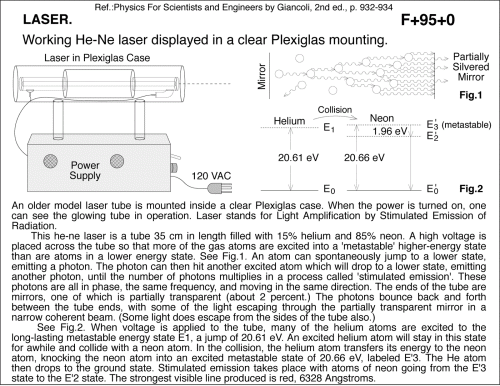Working helium-neon laser in transparent housing.
Primary tabs
Working He-Ne laser displayed in a clear Plexiglas mounting. An older model laser tube is mounted inside a clear Plexiglas case. When the power is turned on, one can see the glowing tube in operation. Laser stands for Light Amplification by Stimulated Emission of Radiation. This he-ne laser is a tube 35 cm in length filled with 15% helium and 85% neon. A high voltage is placed across the tube so that more of the gas atoms are excited into a 'metastable' higher-energy state than are atoms in a lower energy state. See Fig.1. An atom can spontaneously jump to a lower state, emitting a photon. The photon can then hit another excited atom which will drop to a lower state, emitting another photon, until the number of photons multiplies in a process called 'stimulated emission'. These photons are all in phase, the same frequency, and moving in the same direction. The ends of the tube are mirrors, one of which is partially transparent (about 2 percent.) The photons bounce back and forth between the tube ends, with some of the light escaping through the partially transparent mirror in a narrow coherent beam. (Some light does escape from the sides of the tube also.) See Fig.2. When voltage is applied to the tube, many of the helium atoms are excited to the long-lasting metastable energy state E1, a jump of 20.61 eV. An excited helium atom will stay in this state for awhile and collide with a neon atom. In the collision, the helium atom transfers its energy to the neon atom, knocking the neon atom into an excited metastable state of 20.66 eV, labeled E'3. The He atom then drops to the ground state. Stimulated emission takes place with atoms of neon going from the E'3 state to the E'2 state. The strongest visible line produced is red, 6328 Angstroms. Ref.:Physics For Scientists and Engineers by Giancoli, 2nd ed., p. 932-934
UCB Index:
F+95+0
UCB Taxonomy:
Popularity:
- Log in to post comments

